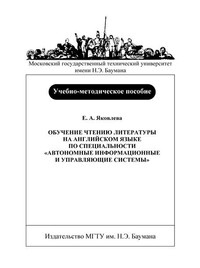Обучение чтению литературы на английском языке по специальности «Автономные информационные и управляющие системы»
Покупка
Тематика:
Английский язык
Год издания: 2007
Кол-во страниц: 28
Дополнительно
Вид издания:
Учебно-методическая литература
Уровень образования:
ВО - Бакалавриат
Артикул: 840503.01.99
Пособие содержит оригинальные тексты из английской и американской научно-технической литературы, а также упражнения и задания, позволяющие освоить и закрепить лексико-грамматический материал, необходимый для понимания и перевода иностранных изданий по специальности. Для студентов старших курсов, обучающихся по специальности «Автономные информационные и управляющие системы».
Скопировать запись
Фрагмент текстового слоя документа размещен для индексирующих роботов
Московский государственный технический университет имени Н.Э. Баумана Е. А. Яковлева ОБУЧЕНИЕ ЧТЕНИЮ ЛИТЕРАТУРЫ НА АНГЛИЙСКОМ ЯЗЫКЕ ПО СПЕЦИАЛЬНОСТИ «АВТОНОМНЫЕ ИНФОРМАЦИОННЫЕ И УПРАВЛЯЮЩИЕ СИСТЕМЫ» Учебно-методическое пособие М о с к в а Издательство МГТУ им. Н.Э. Баумана 2 0 0 7
УДК 802.0 ББК 81.2 Англ-923 Я-474 Рецензент И.В. Стасенко Яковлева Е.А. Я-474 Обучение чтению литературы на английском языке по спе- циальности «Автономные информационные и управляющие системы»: Учеб.-метод. пособие. – М.: Изд-во МГТУ им. Н.Э. Баумана, 2007. – 28 с. Пособие содержит оригинальные тексты из английской и американской научно-технической литературы, а также упражнения и задания, позволяющие освоить и закрепить лексико-грамматический материал, необходимый для понимания и перевода иностранных изданий по специальности. Для студентов старших курсов, обучающихся по специальности «Автономные информационные и управляющие системы». Ил. 1. Библиогр. 6 назв. УДК 802.0 ББК 81.2 Англ-923 Учебное издание Екатерина Александровна Яковлева Обучение чтению литературы на английском языке по специальности «Автономные информационные и управляющие системы» Редактор Н.М. Маслова Корректор Р.В. Царева Компьютерная верстка А.Ю. Ураловой Подписано в печать 12.03.2007. Формат 60×84/16. Бумага офсетная. Печ. л. 1,75. Усл. печ. л. 1,63. Уч.-изд. л. 1,45. Тираж 100 экз. Изд. № 137. Заказ Издательство МГТУ им. Н.Э. Баумана 105005, Москва, 2-я Бауманская ул., 5 © МГТУ им. Н.Э. Баумана, 2007
ПРЕДИСЛОВИЕ Пособие содержит оригинальные тексты из английской и американской научно-технической литературы (с элементами адаптации лишь в особенно трудных для перевода случаях) как для самостоятельной работы студентов, так и для аудиторных занятий под руководством преподавателя. Каждый из трех разделов включает лексические и грамматические упражнения и задания, выполняя которые, студенты овладевают навыками перевода с английского языка на русский и с русского на английский, а также развивают навыки устного обсуждения вопросов, связанных с изучаемой тематикой. Овладение терминологией в рамках специальности и необходимой общеупотребительной лексикой позволяет студентам и будущим специалистам получать из иностранных источников информацию, нужную им в исследовательской и другой работе. Пособие предназначено для студентов старших курсов, обучающихся по специальности «Автономные информационные и управляющие системы» на факультете «Специальное машиностроение».


